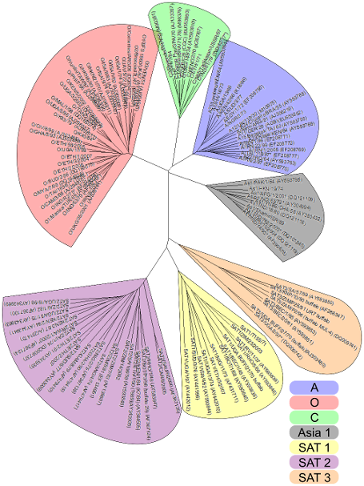Foot-and-mouth disease virus (FMDV) has seven distinct serotypes named O, A, C, SAT 1, SAT 2, SAT 3 and Asia 1.

In 1922 Vallée and Carré demonstrated that there were two serotypes of FMDV (Vallée & Carré, 1922). They named these Vallée O and Vallée A, after the regions they orginated from (department of Oise in France and Germany [Allemagne in French]). Four years later Waldmann and Trautwein demonstrated the existance of three serotypes (Waldmann & Trautwein, 1926). Which they named Waldmann A, B and C. Waldmann A and Waldmann B were found to be the same as Vallée O and Vallée A, respectively. While Waldmann C remained as a distinct third serotype. The names of Vallée O, Vallée A and Waldmann C were later shortened to O, A and C.
Two new serotypes were identified in 1948 in samples from Bechuanaland (Botswana) and Northern Rhodesia (Zambia) (Brooksby, 1958). Retrospective testing of samples from Southern Rhodesia (Zimbabwe) from the 1930s found both of these new serotypes and a third new serotype as well. These new serotypes were named Southern African Territories 1 to 3 (abreviated to SAT 1, SAT 2 and SAT 3).
The serotype Asia 1 was identified in the early 1950s in viruses isolated from India and Pakistan (Dhanda et al., 1957 and Brooksby & Rogers, 1957).
Each serotype can be genetically split into various topotypes and lineages.Prototype strains for all serotypes, topotypes and lineages
How to write foot-and-mouth disease virus
Species name (Foot-and-mouth disease virus)
The International Committee on Taxonomy of Viruses (ICTV) gives advice on how to write virus species names in it's Frequently Asked Questions.ICTV website
Serotype-Topotype-Lineage
When writing down the combination of serotype, tototype and lineage of a strain of foot-and-mouth disease virus the FMDV Nomenclature Working Group suggests the following format:
The serotype, abreviated topotype and lineage in this order, each seperated by a forward slash (/). If there is a sub-lineage it is appended to the Lineage as a superscript:
SEROTYPE /TOPOTYPE ABBREVIATION/LineageSUB-LINEAGE
(for example: O/ME-SA/PanAsia-2TER-08, A/ASIA/Iran-05HER-10, Asia 1/ASIA/Sindh-08, etc.)
O, A, C, Asia 1, SAT 1, SAT 2 and SAT 3.
Serotypes should always be written in upper case. The exception to this is Asia 1, which is written in lower case with an upper case A.
For the SAT 1 to 3 serotypes and Asia 1 there should be space between the letters and the number.
Topotypes are written in upper case.
Abbreviations for the topotpyes (shown in brackets below) are written in upper case.
O: CATHAY, EAST AFRICA 1 (EA-1), EAST AFRICA 2 (EA-2), EAST AFRICA 3 (EA-3), EAST AFRICA 4 (EA-4), WEST AFRICA (WA), EUROPE-SOUTH AMERICA (EURO-SA), INDONESIA-1 (ISA-1), INDONESIA-2 (ISA-2), MIDDLE EAST-SOUTH ASIA (ME-SA) and SOUTHEAST ASIA (SEA)
A: AFRICA, ASIA and EUROPE-SOUTH AMERICA (EURO-SA).
C: AFRICA, ASIA and EUROPE-SOUTH AMERICA (EURO-SA).
SAT 1: Numbered using roman numerals (currently I to XIII).
SAT 1 topotype I is also know as NORTHWEST ZIMBABWE (NWZ), II as SOUTHEAST ZIMBABWE (SEZ), III as WESTERN ZIMBABWE (WZ), IV as EAST AFRICA 1 (EA-1), VII as EAST AFRICA 2 (EA-2) and VII as EAST AFRICA 3 (EA-3).
SAT 2: Numbered using roman numerals (currently I to XIV).
SAT 3: Numbered using roman numerals (currently I to V).
SAT 3 topotype I is also know as SOUTHEAST ZIMBABWE (SEZ), II as WESTERN ZIMBABWE (WZ), III as NORTHWEST ZIMBABWE (NWZ) and V as EAST AFRICA (EA).
Asia 1: ASIA
There are a wide range of lineage names and no single way of writing them all. Please write them in line with how they are written in our table of strains for prototype strains.
References
Vallée, H., & Carré, H. (1922). Sur la pluralité du virus aphteux. Comptes rendus de l'Académie des sciences Paris, 174, 1498-1500.
Waldmann, O., & Trautwein, K. (1926). Experimentelle Untersuchungen über die Pluralität des Maul-und Klauenseuchevirus. Berliner tierärztliche Wochenschrift, 42, 569–571.
Brooksby, J. B. (1958). The virus of foot-and-mouth disease. Advances in Virus Research, 5, 1-37. (article online)
Dhanda, M.R., Gopalakrishnan, V.R., Dhillon, H.S. (1957). Note on the occurrence of atypical strains of foot-and-mouth diseases virus in India. Indian Journal of Veterinary Science and Animal Husbandry, 27, 79–84. (pdf)
Brooksby, J.B., & Rogers, J. (1957). Methods used in typing the virus of foot-and-mouth disease at Pirbright, 1950–55. In, Methods of typing and cultivation of foot-and-mouth disease virus:Project No. 208 (31-34). Paris, France: European Productivity Agency of the Organisation for European Economic Co-operation (OEEC).
